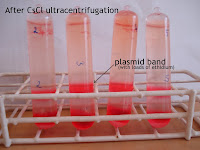From cells to plasmid
 Over the last days, one of my laboratory quests was carrying out a couple of maxi-prep plasmid DNA isolations via alkaline lysis and a Caesium Chloride ultracentrifugation. Today - eventually, after a dialysis and phenol-chloroform purification step - I bore the fruits of my hard work when I precipitated the relatively pure plasmid in ethanol. And merely for the matter of showing you the beauty of a «snow-storm in an eprouvette» I signed up at YouTube and uploaded a little movie-clip I made. You have permission to be amused by my Austrian accent.
Over the last days, one of my laboratory quests was carrying out a couple of maxi-prep plasmid DNA isolations via alkaline lysis and a Caesium Chloride ultracentrifugation. Today - eventually, after a dialysis and phenol-chloroform purification step - I bore the fruits of my hard work when I precipitated the relatively pure plasmid in ethanol. And merely for the matter of showing you the beauty of a «snow-storm in an eprouvette» I signed up at YouTube and uploaded a little movie-clip I made. You have permission to be amused by my Austrian accent.
Labels: final year research, random science
3 Comments:
I like the accent. :)
Stupid question: What's responsible for the glowy pink color in the top photo?
The glowy colour is caused by an immense concentration of Ethidium Bromide. It's an intercalating agent used to stain DNA on e.g. agarose gels. In large scale plasmid purification it's "abused" for letting genomic DNA and plasmid DNA have different densities. Plasmid DNA is a covalently closed circle (CCC) and can only unwind to a certain extend, when Ethidium intercalates between basebair-stacks. Genomic DNA is linear and doesn't have this constrain, therefore increasing more in density. Et voila, they can be separated in a CsCl gradient. The cool thing about CsCl is that it build it's own gradient after spinning it at high speed (>50k rpm) for "some" time (usually more than 24h).
OH YEAH. Duh. I forgot about that! It's been a loooong while since I last saw ethidium bromide (or poured a gel, for that matter).
Post a Comment
« Home